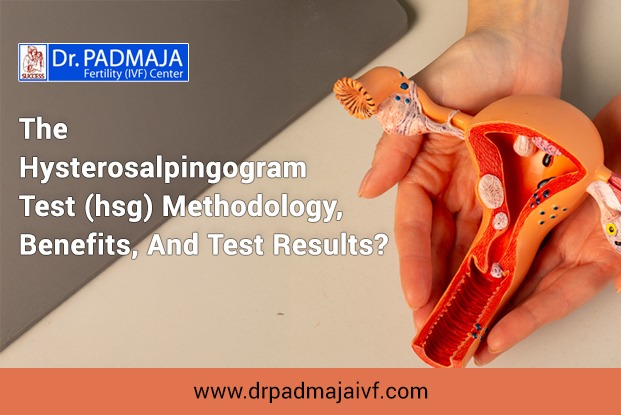Fertility issues affect millions of couples globally, and early diagnosis is the key to effective treatment. One of the most commonly used diagnostic tools in fertility assessments is the Hysterosalpingogram (HSG). If you’ve been trying to conceive for a while without success, your fertility specialist might recommend this test to evaluate the health of your uterus and fallopian tubes.
At top-rated fertility treatment centers like Dr Padmaja IVF Center, which is widely regarded as the best fertility centre in Hyderabad, the HSG test is part of a comprehensive approach to identifying and treating infertility. In this blog, we’ll walk you through the methodology of the HSG test, its benefits, and how to interpret the results.
What is an HSG Test?
A specialist X-ray procedure called a hysterosalpingogram (HSG) is performed to evaluate a woman’s fallopian tubes and uterus. The goal is to determine whether there are any blockages or abnormalities that might prevent sperm from reaching the egg or hinder the implantation of a fertilized egg.
The test is commonly done in fertility hospitals and infertility centres in Hyderabad as part of a routine fertility evaluation. It’s a simple, outpatient procedure that provides critical insights into a woman’s reproductive health.
Methodology of the HSG Test
The HSG test is usually scheduled after menstruation but before ovulation (between day 7 and 10 of your cycle) to avoid any chance of testing during early pregnancy. Here’s how the procedure works:
Step-by-Step Process:
Preparation: You’ll be asked to lie on an examination table, similar to a pelvic exam.
Contrast dye insertion: After passing a tiny catheter through the cervix, a contrast dye is gradually introduced into the uterus.
X-ray Imaging: As the dye flows through the uterus and fallopian tubes, a series of X-ray images are taken to observe the movement of the dye. The dye will seep through the tubes and into the abdominal cavity if they are open.
Duration: It typically takes ten to fifteen minutes to complete the entire process.
Patients may experience mild cramping during the test, similar to menstrual cramps, but the discomfort is temporary.
Benefits of the HSG Test
The HSG test plays a crucial role in diagnosing infertility and guiding further treatment. Here are the key benefits:
1. Detects Blockages in Fallopian Tubes
Often, infertility is caused by blocked fallopian tubes. The HSG test identifies if either or both tubes are blocked, helping doctors determine whether natural conception is possible or if advanced treatments like IVF treatment in Hyderabad are needed.
2. Evaluates Uterine Health
The test can reveal abnormalities in the uterine cavity such as fibroids, polyps, adhesions, or congenital issues that may interfere with implantation or increase the risk of miscarriage.
3. Guides Fertility Treatment Plans
Knowing the exact condition of the uterus and fallopian tubes helps infertility doctors in Hyderabad recommend the most appropriate fertility treatments—whether it’s IUI, IVF, or ICSI in Hyderabad.
4. May Temporarily Increase Fertility
Interestingly, some women report getting pregnant naturally shortly after the test. The dye used may help flush out minor blockages or debris, slightly increasing fertility for a short period.
Understanding HSG Test Results
Following the test, your fertility specialist will go over the X-ray pictures and talk with you about the findings. Here’s what the outcomes generally mean:
1. Normal Result
Open Fallopian Tubes: The dye enters the abdominal cavity unhindered by either tube.
Normal Uterine Shape: No abnormalities detected.
Next Step: Depending on your partner’s sperm health and other factors, the doctor may recommend timed intercourse, IUI, or basic fertility support.
2. Blocked Fallopian Tubes
One or Both Tubes Blocked: The dye does not pass through one or both tubes.
Next Step: IVF may be recommended, as fertilization outside the body bypasses the need for open tubes.
3. Uterine Abnormalities
Fibroids, Polyps, or Scarring: May require surgical correction before further treatment.
Next Step: Hysteroscopy or laparoscopy might be recommended to correct the issue before starting fertility treatments.
At the DrPadmaja Fertility Center, patients receive personalized counseling after the HSG test to understand the findings and decide on the best way forward. This compassionate, patient-centered care is what makes it one of the best IVF centers in Hyderabad.
Where to Get an HSG Test Done in Hyderabad?
When considering an HSG test or any fertility evaluation, it’s important to choose a reliable and well-equipped center. The Dr Padmaja IVF Center, known for its high IVF success rate in Hyderabad, is a top choice. The center is staffed by experienced DrPadmaja infertility doctors who specialize in diagnosing and treating a wide range of fertility issues.
Whether you’re looking for IUI centres in Hyderabad, IVF centres, or simply want to understand your reproductive health better, the team at Dr Padmaja IVF is equipped with cutting-edge technology and years of experience.
Conclusion
The Hysterosalpingogram (HSG) test is a vital first step in the fertility journey. It provides valuable insights into your uterine and tubal health and helps doctors design a treatment plan tailored to your needs. Whether it’s IUI, IVF, or ICSI in Hyderabad, the information gathered from this test will guide you toward the most effective path to parenthood.
If you’re searching for the best fertility centre, look no further than Dr Padmaja IVF Center, a trusted name among fertility treatment centers in Hyderabad. With expert doctors, affordable IVF cost, and compassionate care, they are committed to turning your dream of having a family into a reality.
About the Author

This blog is penned by a devoted content specialist passionate about raising awareness around fertility treatments and emotional well- being. With in- depth disquisition on motifs like IVF and fertility, the thing is to give precious perceptivity for couples on their trip to parenthood.
Frequently Asked Questions (FAQs)
- What is a Hysterosalpingogram (HSG) test?
An HSG is a specialized X-ray procedure used to examine a woman’s uterus and fallopian tubes. It helps identify blockages, abnormalities, or structural issues that may be contributing to infertility.
- Why is the HSG test important in fertility evaluations?
The HSG test can detect blocked fallopian tubes, uterine polyps, fibroids, adhesions, or abnormalities in the uterus — all of which may affect conception or increase the risk of miscarriage.
- How is the HSG test performed?
During the test, a contrast dye is gently injected into the uterus through the cervix. X-ray images are then taken to track the dye’s flow through the uterus and fallopian tubes. The test usually takes 10–20 minutes.
- Is the HSG test painful?
Some women experience mild to moderate cramping, similar to menstrual cramps, during the procedure. Discomfort is typically short-lived and subsides soon after the test.
- When is the best time to schedule an HSG test?
The test is usually scheduled between Day 7 and Day 10 of the menstrual cycle (after your period ends but before ovulation) to ensure accurate results and avoid disrupting a potential early pregnancy.
- Can the HSG test improve fertility?
In some cases, the HSG test may temporarily improve fertility by flushing out minor blockages or debris in the fallopian tubes, increasing the chance of natural conception shortly after the test.
- What happens if my tubes are blocked?
If one or both tubes are blocked, your doctor may suggest further diagnostic procedures like laparoscopy or recommend treatments such as IVF, depending on the severity and location of the blockage.

